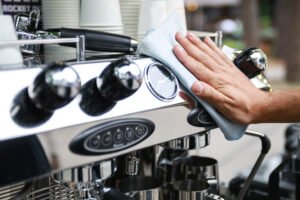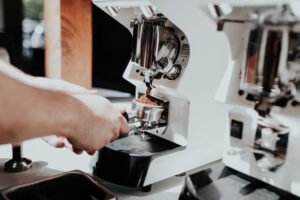Choosing the right coffee grinder can make a world of difference in the quality and flavor of your coffee. For businesses, baristas, and coffee enthusiasts alike, a good grinder is essential to achieve consistent, well-extracted coffee. This guide will help you understand the different types of grinders, key features to look for, and how to select the best grinder for your needs.
1. Why a Quality Grinder Matters
A coffee grinder is more than just a tool; it directly impacts the taste of your coffee. A consistent grind size is crucial for optimal extraction, which affects the flavor, strength, and aroma of the final cup. An inconsistent grind can lead to over-extraction or under-extraction, resulting in bitter or weak flavors. A quality grinder allows for precise control over grind size, ensuring you get the most out of your coffee beans.
2. Types of Coffee Grinders
There are several main types of coffee grinders, each with its pros and cons. Understanding these types will help you choose the right one based on your specific needs.
a) Blade Grinders
Blade grinders use rotating blades to chop coffee beans. They are affordable and easy to use, making them popular for casual home use. However, they tend to produce an inconsistent grind, which can affect the quality of the coffee.
- Pros: Affordable, simple to operate, widely available.
- Cons: Inconsistent grind size, limited control, not ideal for espresso.
b) Burr Grinders
Burr grinders use two revolving abrasive surfaces (burrs) to grind the coffee beans. This method provides a more uniform grind size, making burr grinders the preferred choice for high-quality coffee.
- Flat Burr Grinders: Known for precision, flat burrs produce a consistent grind and are commonly used in commercial settings. However, they can be more expensive and require regular cleaning.
- Conical Burr Grinders: Conical burrs are quieter, generate less heat, and are easier to clean. They’re popular in both commercial and high-end home use.
- Pros: Consistent grind, adjustable settings, suitable for various brew methods.
- Cons: Higher cost, requires regular cleaning and maintenance.
c) Manual Grinders
Manual grinders are hand-operated and usually use conical burrs. They’re portable, affordable, and a great choice for coffee lovers who appreciate the hands-on experience.
- Pros: Portable, affordable, quiet operation.
- Cons: Time-consuming, limited capacity, may require effort for finer grinds (e.g., espresso).
Manual grinders are best for low-volume needs, like home use or traveling. For businesses, electric burr grinders are usually more practical.
3. Key Features to Look for in a Grinder
When choosing a coffee grinder, consider the following features to ensure it meets your specific needs:
- Grind Size Adjustability: The ability to adjust grind size is essential, especially for businesses that serve different coffee styles, from espresso to French press. A grinder with a wide range of settings offers greater flexibility.
- Grind Consistency: Consistency is key for flavor. Burr grinders, especially flat burr grinders, provide the most consistent grind. This is particularly important for espresso, where uniform particles are crucial for even extraction.
- Capacity: Consider the volume of coffee you plan to grind regularly. For high-demand settings like coffee shops, a grinder with a larger capacity hopper and grounds container will save time.
- Speed and Heat Control: High-speed grinders generate heat, which can impact the flavor of the coffee. Look for grinders with gear reduction or low RPM (revolutions per minute) to minimize heat buildup.
- Ease of Cleaning: Coffee grinders require regular cleaning to prevent stale coffee oils from affecting flavor. Burr grinders with removable burrs or easy-access chutes make maintenance simpler.
4. Choosing the Right Grinder Based on Brewing Method
Different brewing methods require specific grind sizes, and some grinders are better suited to certain methods:
- Espresso: Espresso requires a very fine, consistent grind. High-end flat burr grinders or dedicated espresso grinders are recommended for the precision needed in espresso shots.
- Pour-Over: For pour-over coffee, a medium-fine grind is ideal. Conical burr grinders work well here, providing enough control and consistency without the high cost of commercial-grade grinders.
- French Press: French press uses a coarse grind. A burr grinder with adjustable settings allows you to switch easily to the coarser grind needed for this method.
- Cold Brew: Cold brew also requires a coarse grind. If you’re primarily making cold brew, look for a grinder that can handle larger, coarser particles consistently.
Choosing a grinder that aligns with your preferred brewing methods ensures you’ll have the correct grind size and quality for each cup.
5. Commercial vs. Home Grinders
If you’re choosing a grinder for a commercial setting, consider investing in a high-capacity burr grinder that can handle daily heavy use. Commercial grinders often have features like larger hoppers, more powerful motors, and advanced controls, making them suitable for cafes or restaurants.
For home use, a mid-range burr grinder is usually sufficient. If you’re experimenting with different brewing methods, choose a grinder with adjustable settings for greater versatility.
6. Budget Considerations
Coffee grinders come in a wide range of prices, from budget-friendly models to high-end commercial machines. Here’s a quick breakdown:
- Under $100: Blade grinders and basic manual grinders are typically available in this range. They’re suitable for casual use but may lack consistency and adjustability.
- $100 – $300: Mid-range burr grinders are available in this range, offering a good balance between quality and price. These grinders are perfect for home use and small offices.
- $300+: High-end grinders, including commercial-grade models, offer precise control, large capacity, and durability. These grinders are ideal for coffee shops or serious coffee enthusiasts.
Remember, a quality grinder is an investment in the taste and quality of your coffee. Spending a bit more upfront can lead to better results in the long run.
Conclusion
A good coffee grinder is essential for achieving great coffee, whether you’re brewing espresso, French press, or pour-over. Understanding the different types of grinders, key features, and how they align with your brewing methods will help you make an informed choice.
Investing in the right coffee grinder can elevate your coffee experience, offering consistency, control, and quality in every cup.





